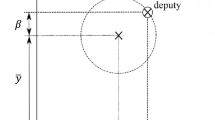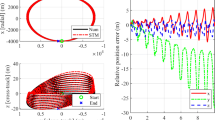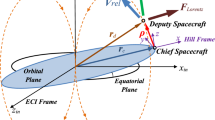Abstract
This paper derives a control concept for formation flight (FF) applications assuming circular reference orbits. The paper focuses on a general impulsive control concept for FF which is then extended to the more realistic case of non-impulsive thrust maneuvers. The control concept uses a description of the FF in relative orbital elements (ROE) instead of the classical Cartesian description since the ROE provide a direct insight into key aspects of the relative motion and are particularly suitable for relative orbit control purposes and collision avoidance analysis. Although Gauss’ variational equations have been first derived to offer a mathematical tool for processing orbit perturbations, they are suitable for several different applications. If the perturbation acceleration is due to a control thrust, Gauss’ variational equations show the effect of such a control thrust on the Keplerian orbital elements. Integrating the Gauss’ variational equations offers a direct relation between velocity increments in the local vertical local horizontal frame and the subsequent change of Keplerian orbital elements. For proximity operations, these equations can be generalized from describing the motion of single spacecraft to the description of the relative motion of two spacecraft. This will be shown for impulsive and finite-duration maneuvers. Based on that, an analytical tool to estimate the error induced through impulsive maneuver planning is presented. The resulting control schemes are simple and effective and thus also suitable for on-board implementation. Simulations show that the proposed concept improves the timing of the thrust maneuver executions and thus reduces the residual error of the formation control.









Similar content being viewed by others
References
Alfriend, K.T., Srinivas, R.V., Gurfil, P., How, J.P., Breger, L.S.: Spacecraft Formation Flying: Dynamics, Control and Navigation. Elsevier, Oxford (2010)
Ardaens, J., D’Amico, S.: Spaceborne autonomous relative control system for dual satellite formations. J. Guid. Control Dyn. 32, 1859–1870 (2009)
Battin, R.H.: An Introduction to the Mathematics and Methods of Astrodynamics, Revised edn. AIAA Education series, Virginia (1999)
Ben Larbi, M.K.: Control Concept for DEOS Far Range Formation Flight. Diploma Thesis—University of Stuttgart (2011)
Ben Larbi, M.K., Bergner, P.: Concept for the control of relative orbital elements for non-impulsive thrust maneuver. Embedded Guidance, Navigation and Control in Aerospace (EGNCA 2012), IFAC (2012)
Ben Larbi, M.K., Luttmann, M., Trentlage, C., Grezik, B., Stoll, E.: Far range formation flight with high risk objects in low earth orbit using relative orbital elements. In: International Astronautical Congress (2016)
Braun, V.: Providing orbit information with predetermined bounded accuracy. Ph.D. thesis, Technische Universitaet Braunschweig, Institute of Space Systems (2016)
Breger, L.S., How, J.P.: Gve-based dynamics and control for formation flying spacecraft. In: 2nd International Symposium on Formation Flying Missions and Technologies (2004)
D’Amico, S.: Autonomous formation flying in low earth orbit. Ph.D. thesis, Technical University of Delft (2010)
Eckstein, M., Rajasingh, C., Blumer, P.: Colocation strategy and collision avoidance for the geostationary satellites at 19 degrees west. In: International Symposium on Space Flight Dynamics (1989)
Kebschull, C., Radtke, J., Krag, H.: Deriving a priority list based on the environmental criticality. In: International Astronautical Congress 2014, Toronto, Canada (2014)
Kessler, D.J., Cour-Palais, B.G.: Collision frequency of artificial satellites: the creation of a debris belt. J. Geophys. Res. 83, 26372646 (1978)
Klinkrad, H.: Space Debris Models and Risk Analysis. Springer, Heidelberg (2006)
Liou, J.C., Johnson, N., Hill, N.: Controlling the growth of future leo debris populations with active debris removal. Acta Astronaut. 66, 648–653 (2010)
Richardson, D.L., Mitchell, J.W.: A third-order analytical solution for relative motion with a circular reference orbit. AAS/AIAA Space Flight Mechanics Meeting, vol. 51 (2002)
Schaub, H., Alfriend, K.: Impulsive feedback control to establish specific mean orbit elements of spacecraft formations. J. Guid. Control Dyn. 24, 739–745 (2001)
Schaub, H., Junkins, J.L.: Analytical Mechanics of Space Systems, 2nd edn. AIAA Education series, Virginia (2009)
Schaub, H., Vadali, S.R., Junkins, J.L., Alfriend, K.T.: Spacecraft formation flying control using mean orbit elements. AAS J. Astronaut. Sci. (2000)
Vaddi, S.S., Alfriend, K.T., Vadali, S.R., Sengputa, P.: Formation establishment and reconfiguration using impulsive control. J. Guid. Control Dyn. 28, 262–268 (2005)
Author information
Authors and Affiliations
Corresponding author
Rights and permissions
About this article
Cite this article
Ben Larbi, M.K., Stoll, E. Spacecraft formation control using analytical finite-duration approaches. CEAS Space J 10, 63–77 (2018). https://doi.org/10.1007/s12567-017-0162-8
Received:
Revised:
Accepted:
Published:
Issue Date:
DOI: https://doi.org/10.1007/s12567-017-0162-8




